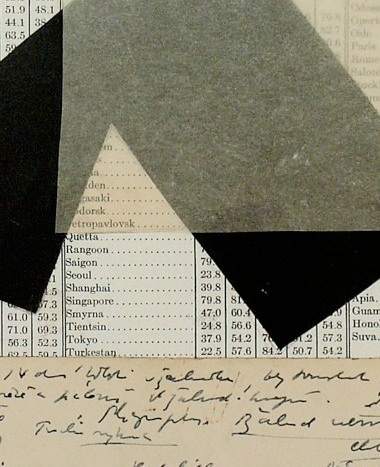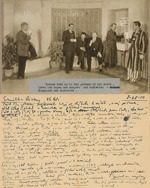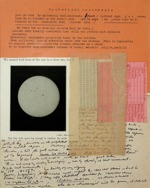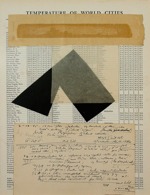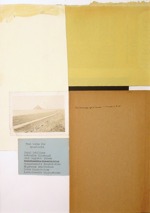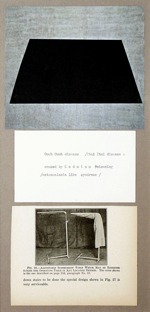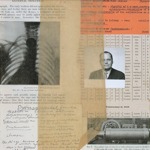Janet Malcolm: Last winter, I came into possession of the papers of an émigré psychiatrist who practiced in New York in the late 1940s and 1950s. The archive included a collection of manila envelopes, around six by ten inches, stuffed with folded sheets of thin paper covered with single-spaced typing: the notes the psychiatrist made after seeing patients (many of them fellow émigrés) in his office. As I studied the sheets with their inky typewriting and 60-year-old paper clips holding them together and leaving rust marks on the surface, my collagist’s imagination began to stir. I began to “see” some version of the collages on view here. The scraps of paper I collect are largely black and white (preferably yellowing white) and have an archaic and melancholy air about them. They hark back to the 19th century and its technological and scientific vernacular. The case studies, with their sad old appearance, were of a piece with this backward-looking aesthetic. Further, in their sometimes almost parodic Freudian interpretations, they summoned a period in psychiatry that is as remote from today’s practice as the manual typewriter is from the Macintosh computer. These collages arose—I’m not sure how—from this encounter with the past.
All images by Janet Malcolm; click to enlarge
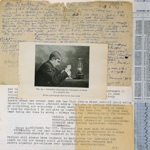
Rabbit’s Ear, 2011, 2011. Paper collage, 9 x 9 inches |
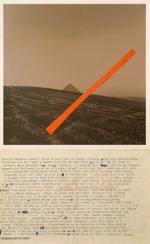
Shelley Winters, 2011. Paper collage, 13 x 8 inches |
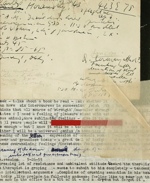
Six Intercourses in Succession, 2011. Paper collage, 7 x 6 inches |
Hilton Als: Journalists—certainly the smart ones—live with the question of veracity, and the question, always, of what makes a truthful account of anything. Journalism becomes art when the writer dares him or herself to ask if reality itself is a form of fiction. Or, more specifically, how real is this or that, given that it’s being filtered through a decidedly subjective perception? Is the sky turning silver moments after seeing it, describing it, as blue mixed with white and flecks of gold, as true as the blue sky one saw moments before? Are the “ums” and various hesitations that punctuate regular speech fictionalized when they’re cleaned up in a magazine?
Janet Malcolm’s work as a journalist who writes about the fiction in real lives, and as a visual artist of the very highest sophistication, is at the center of the questions illustrated above. Indeed, her work in both mediums asks those questions more astutely than that of most other writers. In our rapidly expanding world of truth in a second, no one can get away much with a lie. Appropriation—collage falls under that heading—is a fact-based art. But it’s the human impulse to make things up. As a collagist of superior skill and feeling, Malcolm creates imaginary worlds but with real newsprint and letters and photographs in them.
In her recent work, she imagines other real-life artists. A significant presence in these recent pieces is the German born Jewish artist Eva Hesse (1936-1970). In 1949 Lost Everything and Too Clinical, Malcom uses copies of photographs of Hesse’s sculptures not so much to call attention to the sculptural elements in her own work—the building of layers with space as another layer—but as a visual element that recalls how Hesse’s early work came about: through appropriation. Living in the Ruhr valley in the mid 1960s, Hesse found her voice as an artist when she started sculpting out of the materials she was literally living with in the factory she and her husband shared: life as the event, with art as its record. Hesse—a Jew displaced by World War II, and then further emotionally displaced by her mother’s suicide—was, despite her past, an artist who was deeply engaged by, and admiring of, the art-making process; her work conveys there is joy to be had in making things, and wit, too.
But there is a sadness shading the arched eyebrow. And despite the decisiveness of Malcolm’s line—one gets the sense that a piece’s various elements have only been put down after drafts, many drafts, and reconsiderations: time and revision as part of life’s collage—the space surrounding her images, and bits of colored paper, or yellowing paper, is filled with a quite deliberate absence, like something abandoned but not forgotten, like bodies we have loved but can love no longer.
In this series, sex, one of life’s more ephemeral and intense activities, happens, but it happens through language—a doctor describing what it means to his subjects, or a patient to himself. In one note a patient writes: “Shelley Winters—special charm in her face—no beasty feelings about her, just charming feelings—now for about four months.” But when does desire not bring out “beasty” feelings, especially when it’s the performer’s job to seduce? One tries to repress one’s “beasty” feelings the better to be socialized. But into what kind of world? A world of repression with its arbitrary rules vis a vis what constitutes a lie, or the truth, or attraction?
Advertisement
Malcolm’s desire to order the world is not so much the desire to re-create or control it as it’s an exploration of its various elements—those moments of being that are no more, and that were as true and fake as anything else. Grief and fiction are the central themes of her collages; the images are made up out of the real stuff of grief, which is to say artifacts from the past, a desire not to let go, and are the visual representations of the will to remember even as time erodes that will, and we are no more. But that’s not entirely true. The others that come after us remember us as Malcolm remembers her dead, or the not-known-at-all, their various fictions and facts intact as they swim in the muddying waters of what we erroneously describe as the real world.
Janet Malcolm: Free Associations is on view through January 14, 2012 at Lori Bookstein Fine Art in New York City. The text by Hilton Als is drawn from a longer essay that appeared in the show’s catalog.

